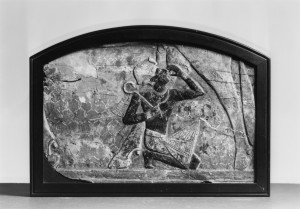Lady of the Sycamore
Continuing our exploration of the sacred trees of the goddess, we turn this week to the Egyptian goddess we know by the Greek name of Hathor. I had research to do for this, because I did not know why Hathor carries the title “Lady of the Sycamore” or why she had a shrine of sycamores in her city along the Nile. My first step was to learn more about the sycamore tree, and I quickly discovered that the tree known as “sycamore” in northern climates is unrelated to the sycamore of Africa and the southern Mediterranean. Hathor’s sycamore is the sycamore-fig, the earliest cultivated fig tree. Its fruit is orange-red, rounder than the common fig, and slightly less sweet. The milky juice of the unripened fruit is used medicinally for skin conditions. The fruit and the wasps pollinating the fruit attract a variety of birds. The tree is long-lived and grows along riverbanks to a height of about sixty feet, much larger than the common fig. The sycamore is a generous tree, offering its fruit year round.
The association of the fig with Hathor evokes the idea of fig wine, as Hathor is a goddess of intoxication. Her new year rites were revels of dancing, music and wine, drawing large numbers of participants. Her priestess cult was an ecstatic one, with a strong emphasis on music. As Patricia Monaghan describes her,…she was the patron of bodily pleasures: the pleasures of sound, in music and song; the joys of the eye, in art, cosmetics, the waving of garlands; the delight of motion in dance and in love; and in all the pleasures of touch.
As her cult spread, Hathor assumed a variety of attributes, even becoming merged with the lion goddess Sekhmet, but she was usually portrayed as a cow, a cow-headed woman, or a woman with cow-horns and moon disk, sometimes suckling her son Ihys (himself a complex deity).As is sometimes the case with life sustaining goddesses, Hathor is also guardian of the dead. Hathor does not seem to have a “death aspect” or twin, but is the same generous, nourishing goddess in life and death. The spirits of the dead hang on her sycamore trees, and she wanders through the groves offering them fresh water. Sycamore was the preferred wood for sarcophagi, and one tomb painting depicts a sycamore tree with singing birds.Even before Hathor’s cult became assimilated with others, her mysteries were probably far more complex than we can fathom from this distance. Clive Barrett conjectures:
The association of joy and intoxication on one hand and death and the underworld on the other suggests that her rituals involved some kind of shamanic practices. Divine madness freed her priests or followers from the mundane world, and with the correct training they were able to move onto other planes and walk with the gods.
Whether the sycamore-fig was ever fermented for Hathor’s rites I was unable to discover through my books and an Internet search. I found that this fig is indeed sometimes fermented into wine, but that it has a vinegary taste that makes it more suitable for medicine than enjoyment. The common fig and the grape, both more suitable for winemaking, had been introduced to Egypt by at least 3000 b.c.e., and there are extensive written records on the production of grape wine. Still, according to Meir Lubetski “The pairing of the sycamore fig and wine was firmly anchored in the cultic practices and in the prevalent landscape of the ancient Egyptians.” He also says that in one funerary ritual the newly deceased king would be fed figs and wine.The sweeter common fig never supplanted the sycamore-fig as an important staple in the Egyptian diet. Hathor’s cult likewise, though it widened and changed, remained popular long into historical times. We generally think of death goddesses as unyielding of temperament like the Sumerian Ereshkigal, frightening in appearance like the Hindu Kali Ma, or stern and scary like the northern European crone goddesses. The worshipers of Hathor had a beautiful, happy lady with them in death. Small wonder the cult of Hathor was one of the most tenacious the world has seen.SourcesBarrett, Clive. The Egyptian Gods and Goddesses: The Mythology and Beliefs of Ancient Egypt. London: Aquarian Press, 1992.Iziko Museums, Figweb.Lubetski, Meir. “Lot’s Choice: Paradise or Purgatory?” in Biblical, Rabbinical and Medieval Studies, Judit Targarona Borras and Angel Saenz-Badilles, eds. Leiden, Netherlands: Brill Academic, 1999.Monaghan, Patricia. The Book of Goddesses and Heroines. St Paul, MN: Llewellyn, 1990.Ray’s Figs website.Wilson, Hilary. Egyptian Food and Drink. Buckinghamshire, UK: Shire Publications, 2008.



Thank you for this fascinating Her-story behind Hathor and the Sycamore fig. “The Queen of the Forest” clip is a sumptuous illustration of the long lived ecological weaving of the tree and its environment that you flesh out between Hathor and Her attributes, symbols and worship. I particularly enjoyed your summing up of Her connection to death as a rare ‘beautiful, happy lady’ of this final rite of passage. This gives us a connection to a powerful and loving Goddess that holds this historical thread of death as a blessed and even nurturing rite.
Yes, I was lucky to find that PBS Nature clip on the sycamore-fig. Hathor is a wonderful, multi-faceted goddess.